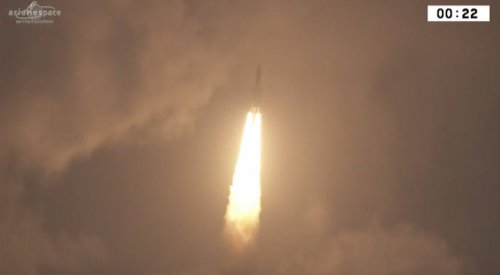WASHINGTON — European launch provider Arianespace completed the first of seven planned launches of its heavy-lift Ariane 5 rocket this year, delivering two telecommunications satellites into geostationary transfer orbit.
The rocket lifted off from the European spaceport in Kourou, French Guiana, at 4:39 p.m. ET with the Sky Brasil-1/Intelsat 32e and Telkom-3S telecommunications satellites.
Sky Brasil-1/Intelsat-32e, built by Airbus Defence and Space in Toulouse, France, is a 6,000-kilogram Ku-band satellite with broadcast capacity for DirecTV Latin America and high-throughput capacity for Intelsat-supported mobility network services. The Intelsat payload overlays capacity with that of Intelsat 29e over the Caribbean and North Atlantic.
Telkom-3S, a product of Thales Alenia Space built in Toulouse and Cannes, France, is a replacement for Telkom-3, a satellite lost in August 2012 due to a Proton rocket failure. The 3,550-kilogram Telkom-3S satellite carries 42 transponders: 24 in C-band, eight with extended C-band and 10 in Ku-band, to provide television and mobile communications for Indonesia and Southeast Asia.
The Ariane 5 mission is the second launch Arianespace has completed this year, preceded by the Jan. 27 Soyuz launch of Hispasat-36W-1. The launch provider is aiming for 12 missions in 2017 — two Soyuz, three Vega and seven Ariane 5.
Intelsat has one more satellite launching this year. Intelsat 35e, another EpicNG-series high-throughput satellite, is planned for a SpaceX Falcon 9 flight in the next few months. Telkom Indonesia has another satellite, Telkom-4, on order from California-based Space Systems Loral, with a launch targeted for 2018.
Arianespace’s next mission is the Vega launch of Sentinel-2B, the second spacecraft in a two-satellite Earth-observation constellation for the European Commission’s Copernicus program. Following the early March launch, Sentinel-2B will join Sentinel-2A, which launched in June 2015, and together they will cover the planet once every five days.
- DARPA satellite-servicing project comes under congressional fire
- Yahsat’s Mahmood on Brazil, Africa, Facebook and future satellites
- Brazilian satellite manufacturer seeks new business as it completes its first satellite
- Ex-Im’s satellite-lending lapse didn’t stop Israel’s Spacecom from buying American
- How Trump Could Wage a War on Scientific Expertise
Share with your friends

(0) Comments
This article comments are currently no :(